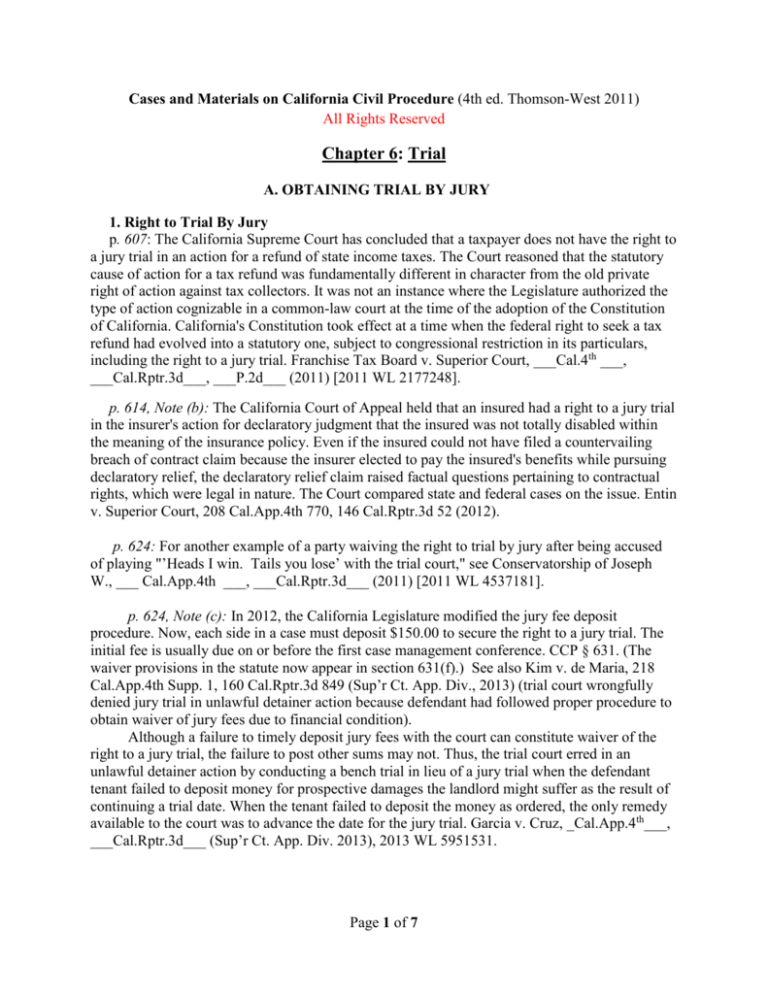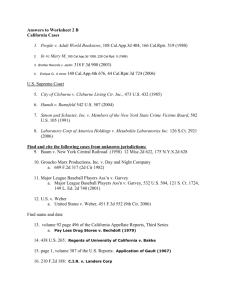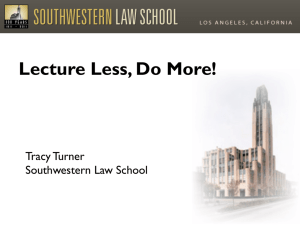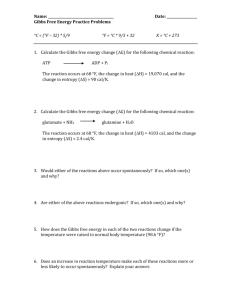
Cases and Materials on California Civil Procedure (4th ed. Thomson-West 2011)
All Rights Reserved
Chapter 6: Trial
A. OBTAINING TRIAL BY JURY
1. Right to Trial By Jury
p. 607: The California Supreme Court has concluded that a taxpayer does not have the right to
a jury trial in an action for a refund of state income taxes. The Court reasoned that the statutory
cause of action for a tax refund was fundamentally different in character from the old private
right of action against tax collectors. It was not an instance where the Legislature authorized the
type of action cognizable in a common-law court at the time of the adoption of the Constitution
of California. California's Constitution took effect at a time when the federal right to seek a tax
refund had evolved into a statutory one, subject to congressional restriction in its particulars,
including the right to a jury trial. Franchise Tax Board v. Superior Court, ___Cal.4th ___,
___Cal.Rptr.3d___, ___P.2d___ (2011) [2011 WL 2177248].
p. 614, Note (b): The California Court of Appeal held that an insured had a right to a jury trial
in the insurer's action for declaratory judgment that the insured was not totally disabled within
the meaning of the insurance policy. Even if the insured could not have filed a countervailing
breach of contract claim because the insurer elected to pay the insured's benefits while pursuing
declaratory relief, the declaratory relief claim raised factual questions pertaining to contractual
rights, which were legal in nature. The Court compared state and federal cases on the issue. Entin
v. Superior Court, 208 Cal.App.4th 770, 146 Cal.Rptr.3d 52 (2012).
p. 624: For another example of a party waiving the right to trial by jury after being accused
of playing "’Heads I win. Tails you lose’ with the trial court," see Conservatorship of Joseph
W., ___ Cal.App.4th ___, ___Cal.Rptr.3d___ (2011) [2011 WL 4537181].
p. 624, Note (c): In 2012, the California Legislature modified the jury fee deposit
procedure. Now, each side in a case must deposit $150.00 to secure the right to a jury trial. The
initial fee is usually due on or before the first case management conference. CCP § 631. (The
waiver provisions in the statute now appear in section 631(f).) See also Kim v. de Maria, 218
Cal.App.4th Supp. 1, 160 Cal.Rptr.3d 849 (Sup’r Ct. App. Div., 2013) (trial court wrongfully
denied jury trial in unlawful detainer action because defendant had followed proper procedure to
obtain waiver of jury fees due to financial condition).
Although a failure to timely deposit jury fees with the court can constitute waiver of the
right to a jury trial, the failure to post other sums may not. Thus, the trial court erred in an
unlawful detainer action by conducting a bench trial in lieu of a jury trial when the defendant
tenant failed to deposit money for prospective damages the landlord might suffer as the result of
continuing a trial date. When the tenant failed to deposit the money as ordered, the only remedy
available to the court was to advance the date for the jury trial. Garcia v. Cruz, _Cal.App.4th___,
___Cal.Rptr.3d___ (Sup’r Ct. App. Div. 2013), 2013 WL 5951531.
Page 1 of 7
p. 625, Note (f): first ¶: Although the contract clause must “clearly and unambiguously show
that the party has agreed to resolve disputes in a forum other than the judicial one, which is the
only forum in which disputes are resolved by juries,” it is not required under CCP § 638 that predispute reference agreements also contain language explicitly waiving the right to a jury trial.
O’Donoghue v. Superior Court, 219 Cal.App.4th 245, ___, 161 Cal.Rptr.3d 609, 619 (2013).
The California Supreme Court has suggested that Treo was correctly decided, at least on
its facts. The Court noted:
[N]either Treo nor Grafton concerned an agreement to arbitrate. Notably, Grafton
explicitly distinguished predispute jury waivers from predispute arbitration agreements,
observing that arbitration agreements are specifically authorized by Code of Civil
Procedure section 1281, and, unlike jury waivers, “represent an agreement to avoid the
judicial forum altogether.” Because public policy strongly favors arbitration as “a speedy
and relatively inexpensive means of dispute resolution,” we decline to read additional
unwritten procedural requirements, such as actual notice and meaningful reflection, into
the arbitration statute.
Pinnacle Museum Tower Association v. Pinnacle Market Development (US), LLC, 55 Cal.4th
223, 245, 145 Cal.Rptr.3d 514, 530, 282 P.3d 1217, 1231 (2012) (CC&Rs in a recorded
condominium declaration, including an arbitration provision, reflected written promises and
agreements which the developer could enforce against the owners association in connection with
a construction defect suit, even though the CC & Rs were created before the association came
into existence).
p. 626: The Northern District of California has also adopted the expedited jury trial as an
optional process available to litigants. See N.D.Cal. Gen. Order No. 64, Expedited Trial
Procedure (July 2011).
p. 633, Note 1: The Ninth Circuit allowed the Southern District of California to use voter
registration lists as the sole source of potential jurors, despite underrepresentation of AfricanAmerican and Latinos and some technical violations of the Jury Selection and Service Act of
1968, 28 U.S.C. § 1867(a) (providing for relief only for substantial failure to comply with JSSA).
United States v. Hernandez-Estrada, ___F.3d ___, 2012 WL 6054775 (9th Cir. 2012). Chief
Judge Kozinski wrote a concurring opinion calling for en banc consideration of the Ninth
Circuit’s rule that a court must use the absolute disparity test and allow up to a 7.7% deviation
for fair cross section purposes. As he noted, “I suspect that a statistician would laugh at our
current methodology.”
p. 643: People v. Mata, 57 Cal.4th 178,158 Cal.Rptr.3d 655, 302 P.3d 1039 (2013) (right to
peremptory challenges is a statutory, not a constitutional privilege).
p. 648 New Note on Expedited Jury Trials: The California Legislature has provided another
option to litigants as of 2011. The new system, based on models tried in New York and South
Carolina, allows the parties to choose an expedited jury trial. CCP § 630.01 et seq. Each side is
limited to 3 hours to present their case to a jury of 8 or fewer members. Each side is permitted 3
peremptory challenges; at least 6 members of the jury must agree on a verdict. With very limited
Page 2 of 7
exceptions, the parties may not bring motions for directed verdict, J.N.O.V. or new trial. As the
jury’s verdict is final and binding with no appeal available—except under extremely limited
circumstances such as misconduct—no court reporter is provided. One important incentive is
that the parties will have agreed in advance to confidential “high–low” figures for damages. The
plaintiff is assured the low figure as a minimum award no matter what the jury actually decides,
while the defendant is certain it will not pay more than the maximum figure. The jury is not told
that these pre-determined limits are in place. The hope is that expedited jury trials will cut costs
for all parties, their insurers, and the courts. See Steven Croley, Summary Jury Trials in
Charleston County, South Carolina, 41 Loy.L.A.L.Rev. 1585 (2008). Under Grafton Partners (p.
635), may parties agree to this new procedure in advance, or just after litigation has commenced?
The Judicial Council report on the new procedure is available at:
<http://www.courtinfo.ca.gov/jc/documents/reports/20101029itema13.pdf>.
3. Jury Panel
p. 643, last para.: Trial judges “should allow” counsel to make a brief opening statement
prior to the beginning of the oral questioning phase of the voir dire process. CCP § 222.5.
p. 652, Note 2: Is it possible for an attorney’s first peremptory challenge be attacked as
motivated by group bias? In People v. McKinzie, 54 Cal.4th 1302, 144 Cal.Rptr.3d 427, 281
P.3d 412 (2012), the defense attorney asked the trial judge for permission to challenge the first
peremptory strike of any African-American because there were no more than four in a panel of
72. The trial court did not grant exactly what the defense attorney requested, but when a
challenge was made, the court investigated and concluded that under the totality of
circumstances, the prosecutor did not engage in group bias. The California Supreme Court saw
no error.
For the first time since the US Supreme Court issued its opinion striking down part of the
Defense of Marriage Act, the Ninth Circuit will be addressing the question of the propriety of
excusing a potential juror on the basis of sexual orientation. SmithKlineBeecham Corp. v. Abbott
Laboratories. Adam Liptak, Court to Decide if Lawyers Can Block Gays from Juries, New York
Times, July 29, 2013.
Kathryne M. Young, Outing Batson: How the Case of Gay Jurors Reveals the Shortcomings
of Modern Voir Dire, 48 Williamette L. Rev. 243 (2011) (addressing the practical implications
of prohibiting sexual orientation as a basis for peremptory challenges).
p. 652, Note 3: In Garcia, the Court of Appeal noted that if, on remand, the trial court
determined that the prosecutor improperly excluded the two prospective jurors, reversal and
retrial were required. But, what is the appropriate remedy when the trial court immediately grants
a Wheeler/Batson motion? A successful movant has a choice. The movant may either: (1) insist
on quashing the entire venire and restarting jury selection from scratch; or (2) assent, even
through counsel, to a narrower solution. That assent may be implied from counsel’s failure to
object to the trial court’s proposed remedy, for example, refusing to dismiss an improperly
challenged potential juror. People v. Mata, 57 Cal.4th 178, 158 Cal.Rptr.3d 655, 302 P.3d 1039
(2013).
Page 3 of 7
p. 654, New Note 8: The California Supreme Court will be exploring the remedy for
addressing a pattern of improper peremptory challenges. May the trial court allow the
prospective juror to remain, despite the peremptory challenge, or is it required to dismiss the
entire venire and start anew? People v. Mata, 203 Cal.App.4th 898, 137 Cal.Rptr.3d 851, review
granted and opinion superseded, (2012).
p. 654, Note on Challenging Judges. The rule that each side is allowed to utilize CCP §
170.6 just once in each action is explored in Pickett v. Superior Court, 203 Cal.App.4th 887, 138
Cal.Rptr.3d 36 (2012).
When a CCP § 170.6 motion is timely is addressed in Entente Design, Inc. v. Superior
Court, 214 Cal.App.4th 385, 389, 154 Cal.Rptr.3d 216 (2013) (“Generally, a section 170.6
challenge is permitted any time before the commencement of a trial or hearing. There are,
however, three exceptions to the general rule: the all purpose assignment rule, the 10–day/5–day
rule, and the master calendar rule.”)
p. 652, Note 4: Given the small number of peremptory challenges available in any case, it
can be difficult to make a prima facie showing that the challenges are being used in a
discriminatory fashion. See, e.g., People v. Taylor, 48 Cal.4th 574, 108 Cal.Rptr.3d 87, 229 P.3d
12 (2010) (no inference of discrimination when three of ten peremptory challenges were used to
exclude two African-American and one Latino prospective juror); People v. Battle, 198
Cal.App.4th 50, 129 Cal.Rptr.3d 828 (2011) (excluding one African-American does not create
inference of discrimination).
B. ADVISING THE JURY
1. Instructions
p. 656: The trial court may look to federal law as a source of jury instructions. Mize-Kurzman
v. Marin Community College District, 202 Cal.App.4th 832, 136 Cal.Rptr.3d 259 (2012).
p. 656: Compare Alamo v. Practice Management Information Corp., ___Cal.App.4th ___,
___ Cal.Rptr.3d ___ 2013 WL 4759007 (trial court erred when it instructed jury with former
version of CACI instructions, but did not err when it refused to instruct jury with a proffered
BAJI instruction) with Veronese v. Lucasfilm, Ltd., 212 Cal.App.4th 1, 151 Cal.Rptr.3d 41
(2012) (trial judge made numerous errors in refusing proffered instructions and also gave at least
one erroneous instruction).
2. Commenting on the Evidence
p. 667: In a case where the trial judge had a propensity to interject a quip wherever possible,
the California Supreme Court stated:
“Although a jury trial, especially for a capital offense, is obviously a serious matter, ‘Wellconceived judicial humor can be a welcome relief during a long, tense trial.’” Still, “‘the court
should refrain from joking remarks which the jury might interpret as denigrating a particular
party or his attorney.’” “When ‘the trial court persists in making discourteous and disparaging
remarks to a defendant's counsel and witnesses and utters frequent comment from which the
jury may plainly perceive that the testimony of the witnesses is not believed by the judge . . .
Page 4 of 7
it has transcended so far beyond the pale of judicial fairness as to render a new trial
necessary.’” But a defendant seeking relief on such a theory must establish prejudice. “‘[O]ur
role . . . is not to determine whether the trial judge's conduct left something to be desired, or
even whether some comments would have been better left unsaid. Rather, we must determine
whether the judge's behavior was so prejudicial that it denied [the defendant] a fair, as
opposed to a perfect, trial.’” We make that determination on a case-by-case basis, examining
the context of the court's comments and the circumstances under which they occurred. Thus,
the propriety and prejudicial effect of a particular comment are judged by both its content and
the circumstances surrounding it.
People v. Abel 53 Cal.4th 891, 914, 138 Cal.Rptr.3d 547, 572, 571 P.3d 1040, 1061
(2012).
C. VERDICTS
1. Types of Verdicts
p. 673, Note 2: A written and signed jury verdict is required under CCP § 618. Polling the
jurors is a means to confirm that the written verdict is correct or that the juror is willing to stand
by his or her vote. However, the act of polling the jurors to determine how each voted —in the
absence of a written and signed verdict—does not itself constitute a “verdict.” Montoya v.
Barragan, 220 Cal.App.4th 1215, 164 Cal.Rptr.3d 100 (2013).
p. 673, Note 3: In Nickerson v. Stonebridge Life Insurance Co., 219 Cal.App.4th 188, 161
Cal.Rptr.3d 629 (2013), the jury was given a special verdict form that asked it to answer
separately whether the conduct of the defendant involved “malice,” “oppression” or “fraud.”
The jury responded, “No” as to malice, “No” as to oppression and “Yes” as to fraud. The dissent
contended that, in light of the instructions given on “malice” and “fraud,” the finding of fraud
was fatally inconsistent with the finding of no malice. In rejecting this contention, the majority
noted that no party contended that the verdict was inconsistent with the statute, which was stated
in the disjunctive. Nevertheless, the majority noted its agreement with the dissent that jurors
should not be presented with a special verdict form that requiring separate findings as to
oppression, fraud, or malice. “Such interrogatories are unnecessary and serve only to open the
verdict to post-trial challenges, as demonstrated by the controversy raised by the dissent.” Id. at
203 n. 3. The California Supreme Court granted review on December 11, 2013. See note below
at p. 703.
2. Impeaching a Verdict
p. 680, Note 3: As of Jan. 1, 2012, CCP 1209 provides that a juror commits contempt of court
by:
(6) Willful disobedience by a juror of a court admonishment related to the prohibition on
any form of communication or research about the case, including all forms of electronic or
wireless communication or research. (Emphasis added.)
In other words, no tweeting or texting by jurors! See Juror Number One v. Superior Court, 206
Cal.App.4th 854, 142 Cal.Rptr.3d 151 (2012) (juror ordered to execute a consent form
authorizing Facebook to release to the court for in camera review all items juror posted during
the trial).
Page 5 of 7
p. 681, Note 3: The process of investigating possible juror misconduct is reviewed in Barboni
v. Tuomi, 210 Cal.App.4th 340, 148 Cal.Rptr.3d 581 (2012) (admissibility of juror declarations;
weighing competing declarations as to what happened during jury deliberations).
D. JUDICIAL CONTROL OF THE JURY
1. Nonsuit
p. 682: In deciding a motion for nonsuit, when reviewing the evidence presented or to be
presented, the court is to consider all undisputed evidence, to disregard any conflicting evidence,
and to give plaintiff's evidence all the value to which it is legally entitled by indulging in every
legitimate inference which may be drawn from that evidence. Nonsuit should be granted if the
court determines that “there is no evidence of sufficient substantiality to support a verdict in
favor of the plaintiff if such a verdict were given.” Lopez v. City of Los Angeles, 196
Cal.App.4th 675, 679 n.1, 126 Cal.Rptr.3d 706 (2011).
2. Directed Verdict
p. 688, Note 1: The similarities between a motion for nonsuit and for directed verdict are
made clear in this Court of Appeal statement:
“In ruling upon a defense motion for a directed verdict, the trial court is guided by the
same standard used in evaluating a motion for a nonsuit.” “[O]nly the evidence most
favorable to plaintiffs need be examined, the testimony of defendant's witnesses may be
disregarded, and if there is any substantial evidence from which the jury could have
found for plaintiffs, the judgment must be reversed.”
Joyce v. Ford Motor Co., 198 Cal.App.4th 1478, ___Cal.Rptr.3d___ (2011).
3. Judgment Notwithstanding the Verdict
p. 693, Note 1: When faced with an appeal from a decision on a Motion for Judgment NOV,
“the standard of review is one in which the appellate court embarks on a search of the record for
evidence that will support the verdict.” Hartt v. County of Los Angeles, ___ Cal.App.4th ___,
___ Cal.Rptr.3d ___ (2011) [2011 WL 811380].
Accord, Simmons v. Ware, 213 Cal.App.4th 1035, 1047, 153 Cal.Rptr.3d 178 (2013) (trial
judge's power to grant a judgment notwithstanding the verdict is identical to the power to grant a
directed verdict).
p. 693, Note 2: The California Supreme Court will be examining whether a trial court: (1)
may grant JNOV before expiration of the time to file a motion for new trial; and (2) must file and
serve written notice of the court's sua sponte motion for JNOV. Webb v. Special Electric Co.,
214 Cal.App.4th 595, 153 Cal.Rptr.3d 882, review granted and opinion superseded, 157
Cal.Rptr.3d 569, 301 P.3d 1176 (2013).
4. Motion for New Trial
p. 694: A new trial order “can be granted only on a ground specified in the motion.” Collins
v. Sutter Memorial Hospital, 196 Cal.App.4th 1, 16, 126 Cal.Rptr.3d 193, 203 (2011). However,
the trial court’s powers in ruling on a motion for a new trial are “plenary,” and the court “has the
power to disbelieve witnesses, reweigh the evidence, and draw reasonable inferences therefrom
contrary to those of the trier of fact.” Barrese v. Murray, ___ Cal.App.4th ___, ___ Cal.Rptr.3d
Page 6 of 7
___ (2011) [2011 WL 3570491].
For an opinion affirming the grant of one motion for a new trial and the denial of another,
both based on claims of newly discovered evidence, see Santillan v. Roman Catholic Bishop of
Fresno, 202 Cal.App.4th 708, 136 Cal.Rptr.3d 197 (2012).
One California Court of Appeal opinion clarifies the legal standard to be applied when
reviewing a grant of a motion for a new trial. If a new trial is granted on the basis of legal error,
the appellate court determines whether the ruling the trial court claims was mistaken is truly
error. If there were no legal errors at trial, the order granting a new trial on that basis is simply
reversed. Even if trial court made a legal error, the moving party must also show the error was
prejudicial. The trial court's judgment on the essentially factual question of whether the legal
error was prejudicial can be reversed only on a strong showing of abuse of discretion. Donlen v.
Ford Motor Co., 217 Cal.App.4th 138, 158 Cal.Rptr.3d 180 (2013).
p. 701, Note 1: Montoya v. Barragan, 220 Cal.App.4th 1215, 164 Cal.Rptr.3d 100 (2013),
addresses the level of detail required when a trial court explains its conclusion that a new trial is
warranted. “If the ground for a new trial concerns insufficiency of the evidence, the trial court
must briefly recite the respect in which the evidence is inadequate, and identify the evidence that
convinces the court that the jury should have reached a different verdict.” Id. at 1222.
p. 703, Note on Review of Punitive Damage Awards: Nickerson v. Stonebridge Life
Insurance Co., 219 Cal.App.4th 188, 161 Cal.Rptr.3d 629 (2013), explains in detail how to
review whether a punitive damage award was excessive. In this case, the Court of Appeal
affirmed a trial court’s remittitur of a jury’s punitive damage award of $19 million down to
$350,000. On December 11, 2013, the opinion was superseded when the California Supreme
Court granted review. The Court noted that the “case includes the following issue: Is an award of
attorney fees under Brandt v. Superior Court (1985) 37 Cal.3d 813 properly included as
compensatory damages for purposes of calculating the ratio between punitive and compensatory
damages where the fees are awarded by the jury, but excluded from compensatory damages
when they are awarded by the trial court after the jury has rendered its verdict?”
p. 702, Note on Additur and Remittitur: There is an editing error in the first paragraph of the
Note. The words “verdict for” in the third line should be in the second line, which should read
“…renders a verdict for Paul…”
p.703, Note on Review of Punitive Damage Awards: The California Court of Appeal
thoroughly examined how to review a punitive damage award to determine if it is excessive
under state and federal law in Bullock v. Philip Morris USA, Inc., 198 Cal.App.4th 543, ___
Cal.Rptr.3d ____ (2011). In a 2-1 decision, the court upheld a verdict of $13.8 million in
punitive damages, plus interest from the entry of the original verdict, in addition to a
compensatory award of $850,000. The dissenting judge thought that the maximum punitive
award could not exceed the single digit ratio suggested by the U.S. Supreme Court in State
Farm. (This case has been the subject of lengthy post-verdict litigation. The original jury
awarded $28 billion in punitive damages to the plaintiff in 2002.)
p. 703, Note on Review of Punitive Damage Awards, What if a defendant corporation’s net
worth is negative? Can it still be punished on the basis of its wealth? Bankhead v. ArvinMeritor,
Inc., 205 Cal.App.4th 68, ___Cal.Rptr.3d___ (2012), explains that net worth is just one of
several ways to measure a defendant’s ability to pay a punitive damage award.
Page 7 of 7







